BASIC SELF-DEFENCE OF TAIJIQUAN
How would you use Taijiquan for self-defence?
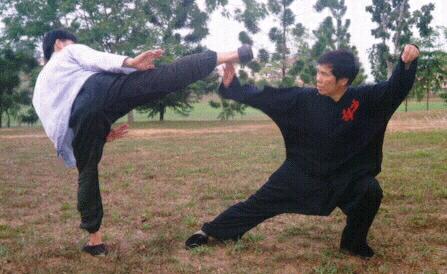
Using Low Single Whip to Counter a High Kick
Taijiquan as a Martial Art
Many people who practice Taijiquan, or Tai Chi Chuan, in the West may be surprised that it is actually an effective martial art. "Quan" (pronounced as "ch'uan") in the term "Taijiquan" is the short form for "quan fa", a Chinese term which corresponds to what westerners would call "kungfu". It is significant to note that "Shaolin Kungfu" is called "Shaolinquan" in Chinese, which is the short form for "Shaolin quan fa". "Taiji" means "the grand ultimate", which is the Chinese term for the cosmos. Hence, Taijiquan really means "Cosmos Kungfu".
Taijiquan or Taiji Dance
Even if your main objective of practicing Taijiquan is not for combat but for health, you still have to practice it as a martial art if you want to get value for your time and effort spent. If you practice it as a dance or some form of physical exercise, which will be inevitable if you miss its martial art aspects, the benefits you get from your Taiji dance or Taiji gymnastics are generally less than what you would get if you spend the same amount of time and effort on conventional dances and gymnastics typically found in the West.
Becoming Healthier and Fitter as You Grow
But if you practice Taijiquan as a martial art (although you may not be interested in fighting), your health benefits can be so remarkable that your dancing and gymnastics friends may find it hard to believe. While they may be panting for breath and often excitable after half an hour of active work-out, you can still be bouncing with energy yet relaxed after sparring for double the time.
More remarkable is that at 50 and beyond, while your peers longed for the health and fitness gone by, you actually feel healthier and fitter than when you were 25. The most remarkable is that while many people yearn for something missing but they do not exactly know what they are seeking, you have inner peace and spiritual purpose in life.
Taijiquan as Personal Cultivation
How does a martial art provide such benefits? Or why do we practice a martial art if our main purpose is not to fight? Herein lie the beauty and wonders of Taijiquan, an exquisite and ingenious art developed by Taoists for "cultivation in normal times, subduing assilants in times of exigencies".
Taoism, it may be significant to clarify, is not a religion as most westerners conceptualize what a religion is. "Tao" means the way, and in this context, the way to good health, longevity and spiritual joy. Explanation on how and why Taijiquan training is a process of such a cultivation is (and will be) found in other webpages; the purpose of this webpage is to illustrate some basic defence techniques of Taijiquan.
Great Arts are Rare
If you have been practicing Taijiquan (or what you think is Taijiquan) for many years, but find yourself no where near this Taoist cultivation, don't despair. Great arts in whatever times and places are rare, although their much diluted versions may be popular.
But at least now you know that Taijiquan is not a dance or gymnastics, but a comprehensive programme for physical, emotional, mental and spiritual cultivation, you would know what to aim for should you decide to continue in its pursue. It is very important to realize that attainment in any art is through dedicated practical training, and not merely through reading or wishful thinking.
Basic Categories of Taijiquan Attacks
The Four Attacks
Attacks of course can come in countless ways, but to enable students to understand attacks better, past masters have classified all attacks into four major categories, namely:
- strikes
- kicks
- falls
- holds
The Four Strikes
Strikes can come from any directions, but past masters have generalized them into four major directions, namely:
- top
- middle
- bottom
- sides
The pictures below illustrate some basic Taijiquan patterns against these four strikes.
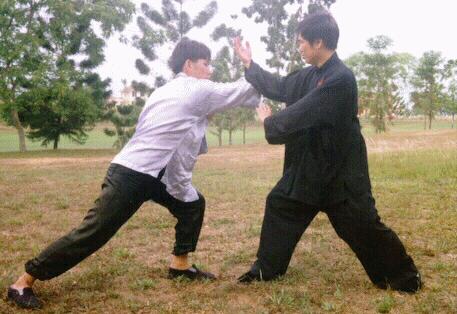
In the picture above, Tai Chee Yong attacks me with a top strike, using the Shaolin pattern "Poisonous Snake Shoots Venum". I counter with the "peng" technique of "Grasping Sparrow's Tail" in Yang Style Taijiquan.
Yang Style is chosen here as it is currently the most widely practiced style. All styles of Taijiquan are effective for combat, and are similar in their basic principles and fundamental movements. Shaolin Kungfu is chosen here for the attack because being the most comprehensive and extensive, it includes all the major attacking techniques of all other martial arts.
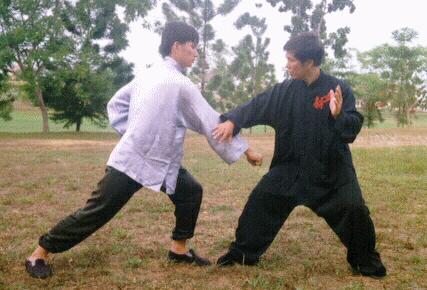
Tai's middle strike in the form of a thrust punch is known as "Black Tiger Steals Heart" in Shaolin Kungfu. It is probably the most common form of attack in most martial arts. I respond with "Green Dragon Presents Pearl", brushing away the thrust punch in a circular movement with one hand, and counter-attacking with the other.
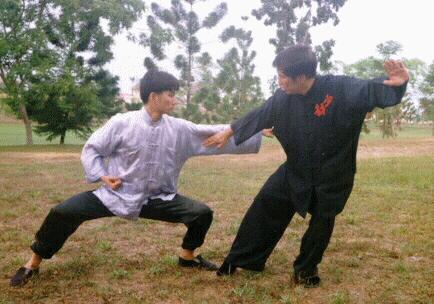
In the third attack, I use "White Crane Flaps Wings" against Tai's bottom strike using "Precious Duck Swims through Lotus"

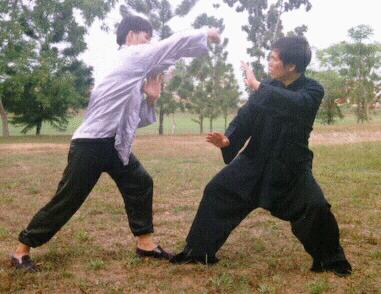

Tai employes a pattern called "Hanging a Golden Star" to implement a side strike to my left temple. Without moving my feet, I retreat my body to avoid the strike, and continue smoothly forward to "float" Tai's elbow and simultaneously strike his ribs, using "Jade Girl Threads Shuttle".
The Four Kicks
Like strikes, kicks are generalized into four major categories, namely- high
- middle
- low
- sideway

As Tai executes a high kick, known as "Kicking the Sky", I shift my body backward to avoid its kicking momentum, using the pattern "Low Single Whip".

In the above picture, I use the "roll-back" technique of "Grasping Sparrow's Tail" to trap Tai's leg in his middle kick called "Happy Bird Hops up Branch".
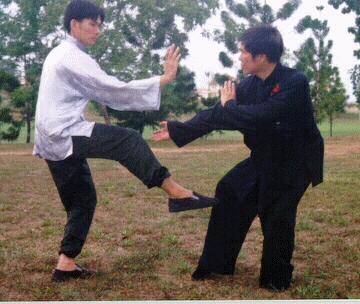
Tai executes a low kick using a pattern called "Yellow Bird Drinks Water". I retreat half a step and strike his shin using "Needle at Sea Bottom".

In the next attack, Tai uses a whirlwind kick (which looks like but is actually different from the round-house kick) in a pattern called "Naughty Monkey Kicks Tree". I step gently to the side away from his kicking momentum, and counter with "Cross-Hand Thrust Kick" intercepting Tai's whrlwind kick at his thigh.
Importance of Skill and Force
One must realize that techniques, like those shown above, constitute only one factor towards combat efficiency. Another more important factor is what the Chinese call "kung" (spelt as "gong" in Romanized Chinese), from which the term "kungfu" derives. There is no equivalent term in English, but may be provisionally translated as "skill and force".
Merely knowing, and even being able to apply, the techniques are grossly inadequate; one must be able to apply the techniques skilfully and forcefully. The pathetic lack of skill and force is probably the most important reason why most kungfu students (which include Taijiquan students, of course) cannot spar effectively. Skill and force need to be developed with a master's supervision, not just read from a webpage or a book.
Seeing the graceful movements of Taijiquan, many people are surprised that it can be used for combat. They will probably be more surprised that these graceful movements are very effective both for countering as well as for implementing felling and gripping attacks. Space limitation and downloading time, however, permit an explanation of only one example in this webpage.
In the first picture below, Tai Chee Yong is about to execute a hip throw. Swiftly I move my back leg backwards and lower my stance, thus thwarting his attempt, as shown in the second picture.
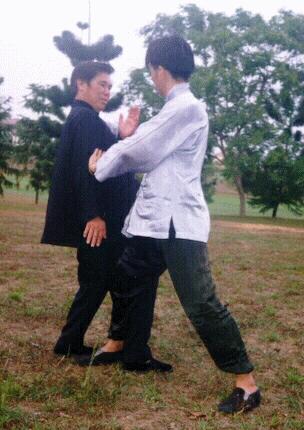
|

|
Following Tai's momentum, I float his left elbow and simultaneously pull down his right forearm to unbalance him. Continuing the movement I fell Tai onto the ground.

|
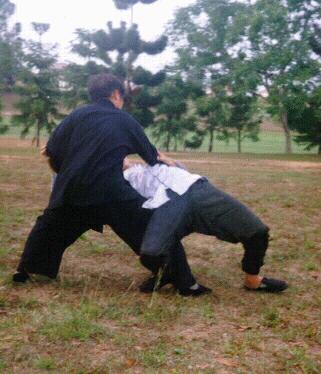
|
Notice that initially Tai placed his right leg behind my right leg with the intention of using it as an anchor to fell me. But by an appropriate shift of my back leg and a gentle rotation of my waist I turn the table against him, using the same anchor to fell him instead.
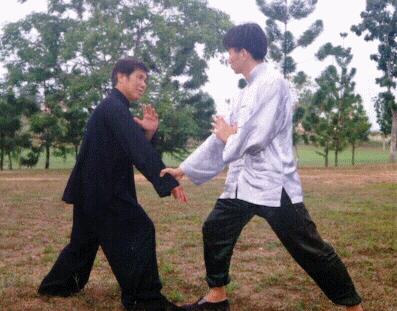
In the picture above Tai grips my right wrist with a tiger-claw. I relax my arm and using my shoulder as pivot, turn my arm in a clockwise direction, simultaneously rotating my waist. This turning will cause Tai to release his grip; otherwise it will dislocate his wrist.
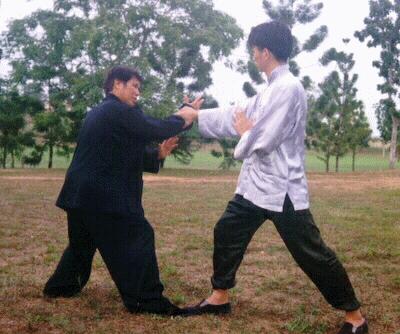
This and the previous example illustrate the Taijiquan tactic of using the oponent's moves against himself. In the previous example, the opponent locked my leg to fell me. By means of a skilful manuovre, I used the same leg lock to fell him instead! In this example, the opponet grips my wrist. With a skilful turn I use his grip to dislocate his wrist!
However I could not dislocate Tai's wrist, because he released his grip. Continuing my turning momentum, I place my left leg behind his right leg, guard his right hand with my right hand, and press my left arm against his left arm pushing it agaist his upper body. By spreading my left arm I fell Tai to the ground.
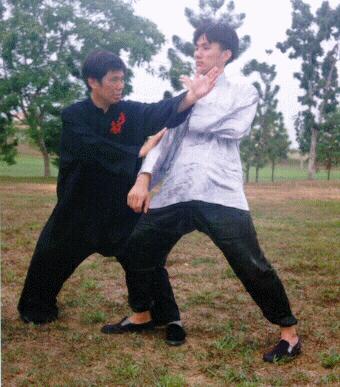
|
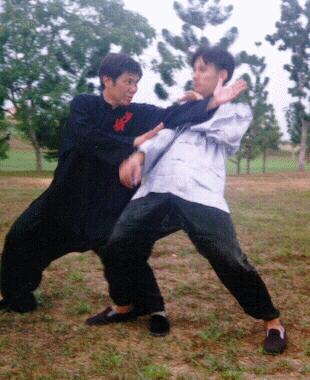
|
If you have any suggestions or questions, please e-mail Sifu Wong Kiew Kit. Please state your name and country as well as mention this webpage as reference.
You can view a selection of Sifu Wong's answers to readers' questions at Question-Answer Series.
